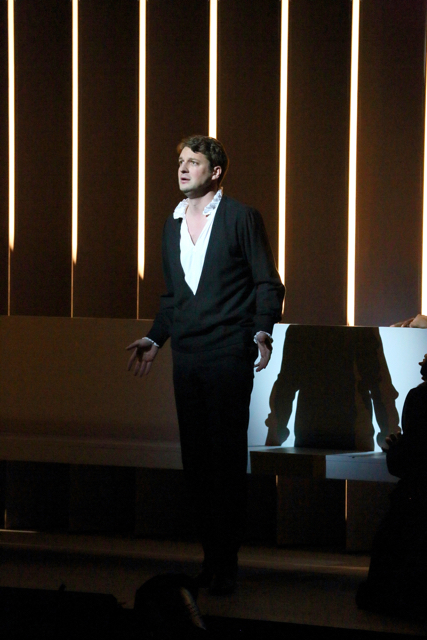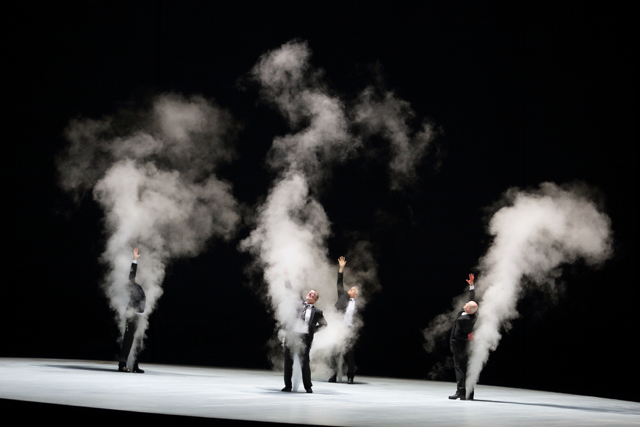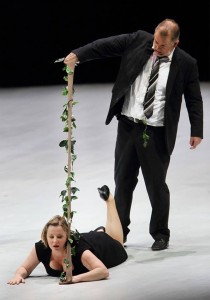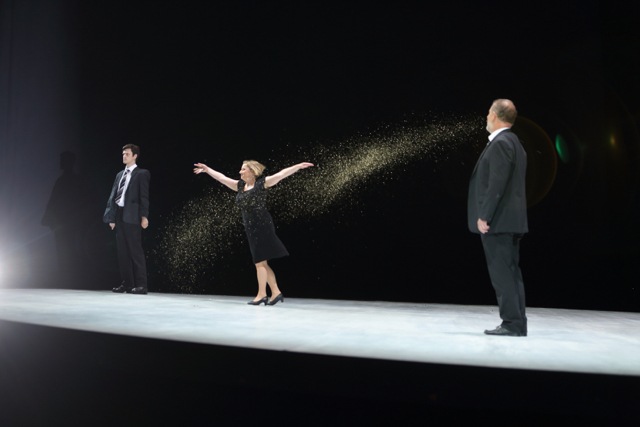Archive for October 2014
Los Angeles Opera Presents Purcell/Bartok Double Bill
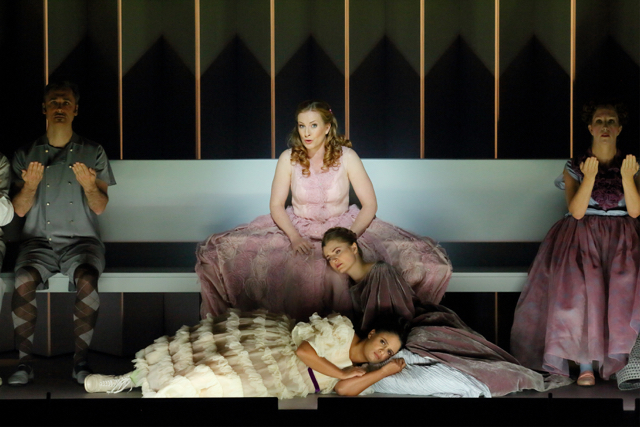
Top to bottom, center: Paula Murrihy as Dido, Kateryna Kasper as Belinda and Summer Hassan as the Second Woman in “Dido and Aeneas.” Photo: Craig Mathew / LA Opera
Los Angeles Opera Presents Purcell/Bartók Double Bill
Review by David Gregson
HENRY PURCELL: Dido and Aeneas
BÉLA BARTÓK: Bluebeard’s Castle
Attending Los Angeles Opera’s current double bill on opening night Saturday, I was mildly surprised to discover that many people do not know Henry Purcell’s Dido and Aeneas very well — or, indeed, at all. If they had the slightest affection for it, stage director Barrie Kosky’s hideously misguided contribution would perhaps have enraged the audience. But I detected nary a boo and Kosky’s ludicrous travesty was met with warm approval. Mark Swed’s predictably glowing review was soon to follow in the Los Angeles Times. Swed would like to see, as I would as well, more adventurous “cutting edge” productions in LA, but I was actually infuriated by this one.
Dido and Aeneas holds (as I have written at this site once before) a very special place in my heart. I discovered the work on an RCA Victor LP recording (which I still own and is actually playable), featuring — of all people! — Kirsten Flagstad as Dido and Elizabeth Schwarzkopf as Dido’s lady-in-waiting, Belinda. A CD exists on Great Recordings of the Century.
Who knew back in 1957 that conductor Geraint Jones and the Mermaid Singers and Orchestra were miles away from anything resembling authentic performance practice! When I first heard the LP on huge clunky monaural headphones at the Andrew Mellon Library at Choate School, all I knew was that this piece deeply moved and delighted me with its innumerable charms and profound pathos. In many ways, it was the first opera I took to heart — every word and every note of it. That and Wagner’s Lohengrin! When you are in the ninth grade (the so-called “third form” at Choate), the paths to discovery are strange.
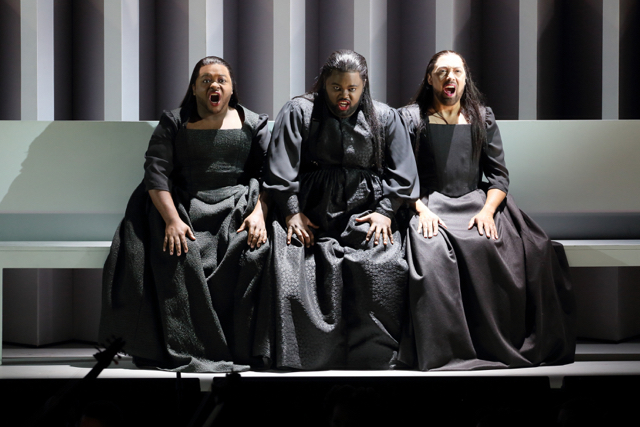
John Holiday (center) as the Sorceress, with G. Thomas Allen (left) as the First Witch and Darryl Taylor (right) as the Second Witch in “Dido and Aeneas.” Photo: Craig Mathew / LA Opera
As I grew older I collected every recording of Dido and Aeneas I could find. At UCSD where I earned a Ph.D. in English Literature, I had a professor that would leave class each session singing “Haste, haste to town,” which I always found hilarious; and when I worked for several years for the United States Navy, I loved to quote, for the benefit of the enlisted men, Nahum Tate’s cynical lyrics on sailors’ infidelity: “Take a boozy short leave of your nymphs on the shore, / And silence their mourning / With vows of returning / But never intending to visit them more.” Lines, I might add, brilliantly set by the composer so that the music underlines their meaning.
To me Henry Purcell is one of the greatest composers, and “Dido’s Lament” (“When I am laid in earth”) is among the loveliest and saddest melodies I know. Recently I heard a wonderful performance of the hour-long opera staged by the Bach Collegium of San Diego under the direction of Ruben Valenzuela. The orchestra consisted of six violins, two violas, violoncello and violone, two theorbos (super-lutes!), guitars and harpsichord. I thought the ensemble was perfect in style and execution — throughly professional. The tempi (much faster than my old Choate recording, of course) were perfectly chosen, and Valenzuela kept the whole hour-long piece totally coherent. That is to say, there was a shape and drive to everything.
The small Dido ensemble currently in Los Angeles also uses strings, theorbos, organ and harpsichord and is excellent. It’s “authentic” music making of the sort I never dreamed possible in 1957. Virtually everything is superb: the orchestra led by Steven Sloane, the chorus as directed by Grant Gershon, and all of the soloists. The tempi are crisp, the score is lovingly nuanced, and the voices perfect for the music. Three superlative countertenors take the parts of the witches. All in all everyone involved could have made a superb recording. The only villain, and one I find unimaginably egregious, is the stage director.
The action, very little of it clear to anyone who has not studied the libretto carefully, takes place along a bench that stretches along a wall from one side of the stage to the other. From the outset, the players are very much like hyperkinetic children. It was hard to tell if they were spasmodic with delight or if they wanted to go to the bathroom. Belinda seemed ready to jump out of her skin, but Kateryna Kasper’s pure soprano transcended the directorial hijinks. I was reminded of the so-called Peanut Gallery on the ancient TV kiddies’ show, Howdy Doody. I also recalled my own baleful history as a stage director. In college I did something similarly sophomoric with Pirates of Penzance because I hated G&S (then, but not now) and I showed my contempt by ordering everyone to do absurd things.
With such magnificent musical resources available, only a totally unmusical philistine like Kosky would require his Dido to go into noisy death-throe convulsions immediately following the famous lament. “Thy hand, Belinda. On thy bosom let me rest,” sings Dido. Well, there was no hand, no bosom, and no Belinda. Dido’s five minutes of vocal agony destroyed the beauty of the final chorus. Not content with creating this infuriating aural distraction, Kosky required the musicians to leave the the pit in a sort of Farewell Symphony enactment. If I had been Murphy (and I didn’t need a job!) I would have refused to follow my lovely rendition of the lament with this destructive stage business.
The witches, by the way, were rather priceless and good additions, but they were also cunning linguists (ahem!), something I did not need to see on stage. The gratuitous nudity among the supernumeraries was inoffensive, but Kosky needed to shock the audience at all costs.
Baritone Liam Bonner made a strong Aeneas. At one point he is supposed to enter with a boar’s head bleeding atop a spear, but this was pantomimed in an odd way that left everyone around me totally confused (to judge from overheard comments). Chorus members cheered and bravoed at the sight of nothing. Bonner amused everybody but me by leaving Dido in a sort of petulance, exiting through the audience, slamming a side door on his way.
In short, Purcell’s lovely little opera was wrecked by the stage director — and as a friend remarked to me, everybody seems to have swilled down the Kool Aid.
Incidentally, before reading some of the program notes, one should read a helpful little best-selling volume from the Princeton University Press — On Bullshit by Harry G. Frankfurt. Instead of just saying he thought Dido and Bluebeard are two short operas we might program together, there is this BS: “Two operas about arrival and departure. Two operas about departure and arrival. Two operas about a woman and a man. Two operas about a man and a woman.” There’s more. For sheer meaningless pretentiousness, this bogus explanation is almost without equal.
But wait. We still have Bluebeard’s Castle to ruin! One of Bartók’s greatest works.
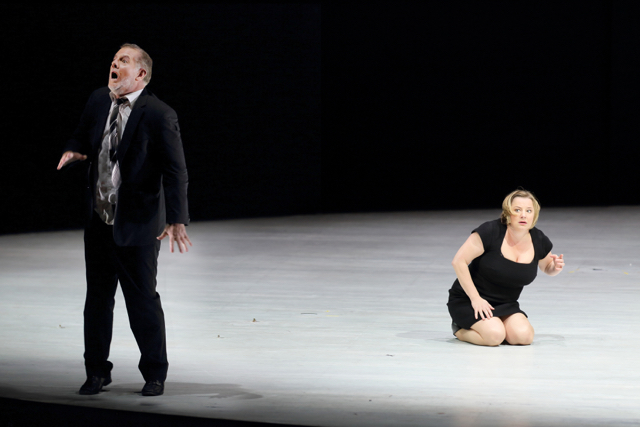
Robert Hayward as Bluebeard and Claudia Mahnke as Judith in “Bluebeard’s Castle.” Photo: Craig Mathew / LA Opera
Kosky is actually on to something with his stage direction here, although the realization of his ideas destroys the ability of the two principal singers to communicate fully with what they do best — sing. They would have been far more successful had they been left to their own devices.
The whole opera, with its symbolic libretto by Béla Balázs, is something of a trick on the audience — not to mention the main female character, Judith. Bluebeard is not the serial killer of fairytale legend, but a real man of some stature. Judith is a femme fatale who digs too deeply into the man she loves and, by doing so, deprives him of his selfhood. She wants to open all the doors of his “castle” — which is, of course, Bluebeard himself. She discovers a torture chamber, a secret garden, fabulous treasure, an armory, a pool of tears, and fabulous vistas that embrace the world. Behind the final door she finds all his former wives, but they are living. They are, of course, also women who have dug too deeply and they walk around in his memories of youth, maturity and advancing age. Kosky brings three silent actors on stage to represent these phases — and they all pair with the former wives in the finale.
I think Judith appears more sympathetic in less radical stagings of this opera. Kosky orders his Bluebeard and Judtih to claw away at one another. Early in the opera, Judith seems to plunge her arm into his side, leaving him bloodied. They run around the stage, they fall down, they get up again, they go at one another physically as if indulging in some extreme form of psychotherapy. Singers Robert Hayward and Claudia Mahnke make the very best of this situation, but the production is against them. It’s essentially an unmusical show. And dragging the subtext up to the surface in such a frontal fashion is, quite frankly, destructive to the emotional impact of the opera.
Ideally, the music puts one through the emotional wringer. And while Bartók was a 20th-century “modern” composer, he was as great at old-fashioned musical scene painting as Wagner. We hear the torture chamber, the luxuriant secret garden of flowers, the sparking jewels of his treasury, and in one magnificent orchestral statement underpinned by a mighty pipe organ, we see his vast lands. For the latter, Kosky and his designers (see below) have provided a steam-shot ejaculation from the pants of four different Bluebeards.
The treasure comes out of one of the Bluebeards like golden pixie dust falling to the floor. The pool of tears (which Bluebeard #1 actually licks with his tongue) drips from the men’s trousers and coat sleeves. The flowers look like a tacky strand of leaves sewn onto stockings. I was reminded of holiday decorations in a cheap Italian restaurant.
Needless to say, despite a fairly decent reading of the score under the direction of Steven Sloane, there was no visual complement to any of the composer’s scene painting. The imagery, for me at least, was constantly making me think of how much better the whole thing would be as a concert performance. The LA Phil, in fact, offered a memorable concert version here not so long ago, fabulously conducted by Esa-Pekka Salonen.
I did not like Kosky’s popular, cinematic The Magic Flute here in LA . Many loved it. But if readers wish to sample how appalling a director he is, just click here and see clips from his Hannover Siegfried in which the evil dwarf Mime is depicted as a Jew wearing a yamaka and Alberich is in blackface.
I do not want to discourage the LA Opera from innovation, but there is good Regietheater and there is bad Regietheater and this double bill is the latter.
—–
Please leave comments below if you wish. Factual corrections are especially welcome.
CAST
Dido: Paula Murrihy*
Aeneas: Liam Bonner
Belinda: (in “Dido and Aeneas”) Kateryna Kasper*
Sorceress: (in “Dido and Aeneas”) John Holiday*
Second Lady: (in “Dido and Aeneas”) Summer Hassan+*
First Witch: (in “Dido and Aeneas”) G. Thomas Allen*
Second Witch: (in “Dido and Aeneas”) Darryl Taylor*
Sailor/Spirit: (in “Dido and Aeneas”) Brenton Ryan+
Bluebeard: Robert Hayward*
Judith: (in “Bluebeard’s Castle”) Claudia Mahnke*
CREATIVE TEAM
Conductor: Steven Sloane
Director: Barrie Kosky
Associate Director: Ute M. Engelhardt*
Scenery and Costume Designer: Katrin Lea Tag*
Lighting Designer: Joachim Klein*
Chorus Director (“Dido and Aeneas”): Grant Gershon
* LA Opera debut artist
+ Domingo-Colburn-Stein Young Artist Program member
SCHEDULE
Saturday October 25, 2014 07:30 PM
Sunday November 02, 2014 02:00 PM
Thursday November 06, 2014 07:30 PM
Sunday November 09, 2014 02:00 PM
Wednesday November 12, 2014 07:30 PM
Saturday November 15, 2014 07:30 PM

